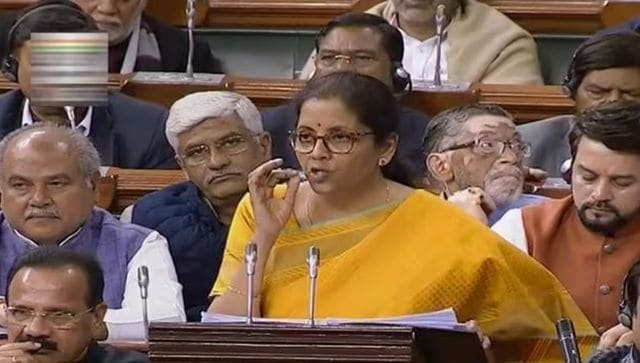
Union Budget 2023-24: Why this year’s Budget needs to be seen through the lenses of India as a rising power

Union finance minister Nirmala Sitharaman. PTi
India has been a low-middle-income country for a decade now, and this decade must be about its transition to middle-middle income status. It also has definitive rising great power aspirations today than ever before.
How should a budget accommodate these ideas? The idea of ‘small government’ is often misunderstood in India, which is probably, now, the largest country by population in the world.
A bit of history is useful. Before 1916, the United States spent only around 2 per cent of national income on public spending mostly on the very basic functions of government – maintaining law and order, and keeping intact property rights.
Between the First and the Second World War, public expenditure grew significantly in America but it was mainly due to defence expenditure for the wars. But between 1945-80, government spending increased rapidly even as GDP (and government revenue) grew in tandem. In Europe, too, what used to be public expenditure levels of 10% of national income at the close of the 19th century, grew in about one hundred years, to around 50 per cent.
There is a crisis today in parts of Europe because national income is not growing anywhere close to the levels at which public expenditure has been committed. But this is sometimes misunderstood in India as a problem of profligacy. It isn’t. It is a problem of growth, and an inability to transition to sustainable methods as prosperity has increased, and rates of growth, slowed.
But, during the time that they were rising to power, both, parts of Europe, and America spent increasingly higher levels of government to provide, critically, mass healthcare and education.
This is an important way for ensuring that growth benefits the societies that are going through, and indeed creating, that momentum. It also ensures that that growth creates further conditions for future growth, as today’s beneficiaries become tomorrow’s customers.
Rising India is likely to signal in this budget that not only must its growth empower grassroots citizens to ensure the least levels of domestic turmoil as the country focusses on expanding its global stature and footprint (no nation can aspire to be a Great Power while having a divided house at home), it also has to spend some of its capacities in assisting other countries. As a net provider of aid now, rather than a recipient, India’s role in providing goods and services around the world is bound to expand and that shall require budgetary imagination. India’s recent act of generosity in helping Sri Lanka tide over its worst economic crisis through significant loans is something that India might have to repeat in other geographies as its strategic footprint increases.
Military expenditure is another area where a rising power like India must focus on spending more money. There are two key principles here. No country has ever risen on the back of ‘borrowed or bought’ weapons. One of the fundamental criteria of Great Power status is the capability to manufacture and sell large-scale weapons. Defence manufacturing is still nascent in India, though in recent years notable efforts has been made. This must rise exponentially and not just in large-scale weaponry but also in building cutting-edge surveillance systems and the use of artificial intelligence in armaments. Building such technology, again, requires thought through financial interventions which one would need to look for carefully in the budget.
One of the things that was noteworthy in the budget last year was the focus on border areas including villages. Since then, the need to focus further on them, especially in the east has become more heightened as recent Chinese misadventures in the Tawang show. India is building bigger, better infrastructure, including a connecting road network replicating what China has on its side, and more resources might be needed to strengthen our peripheries which hold the key to our sovereignty.
The advancement of India’s digital economy is both a major effort at democratizing government at home and a major offering as part of its international outreach. One of the ways in which India will be able to demonstrate its superiority is to showcase that using digital technology and widespread insurance innovation, it can provide effective healthcare to all without burdening the exchequer with ever-ballooning costs – not least because India has probably already become the most populous country in the world. If done well, and in participation with private healthcare centres and hospitals which are mandatorily made part of the solution and not merely institutions of extraction, digital health could be India’s NHS, something treasured at home, and flaunted abroad as a model of development and a citizen-first approach. What attention is paid in this year’s budget to furthering the cause of digital India and especially digital health would give us an assessment on what commitments India is prepared to make in this area.
Budgets are always instruments, not only for assessing expenditure and income, but also for projecting what kind of nation a country wishes to be seen as. This year more than ever the budget needs to be seen through the lenses of India as a rising power and whether the country is willing to make policy decisions and resource allocation which assists in its role as a rising power.
The writer is a multiple award-winning historian and author. Views expressed are personal.
Read all the Latest News, Trending News, Cricket News, Bollywood News,
India News and Entertainment News here. Follow us on Facebook, Twitter and Instagram.
Stay connected with us on social media platform for instant update click here to join our Twitter, & Facebook
We are now on Telegram. Click here to join our channel (@TechiUpdate) and stay updated with the latest Technology headlines.
For all the latest Sports News Click Here
For the latest news and updates, follow us on Google News.

